

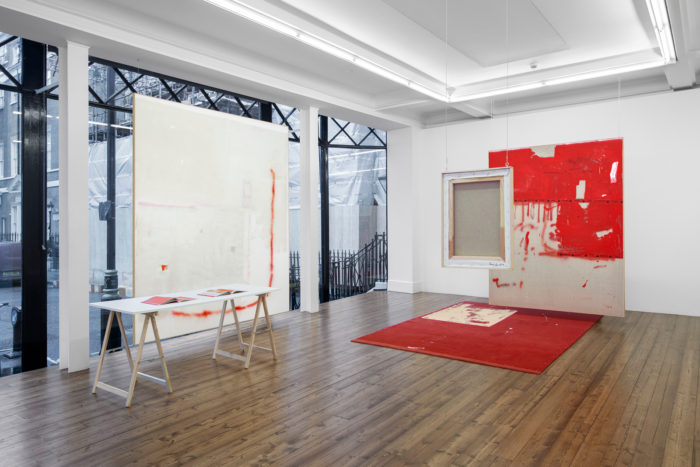
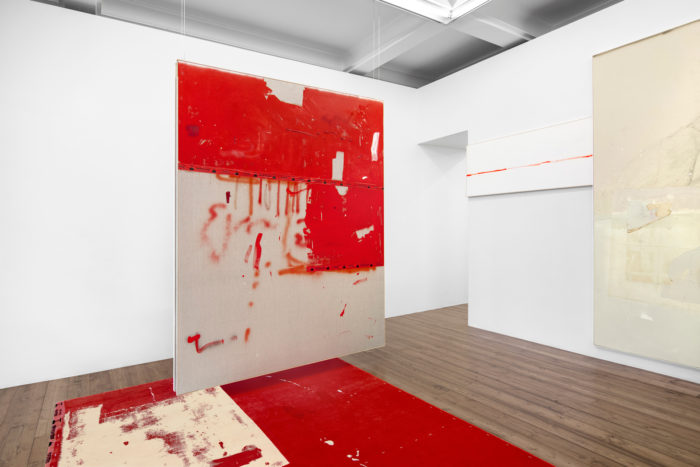
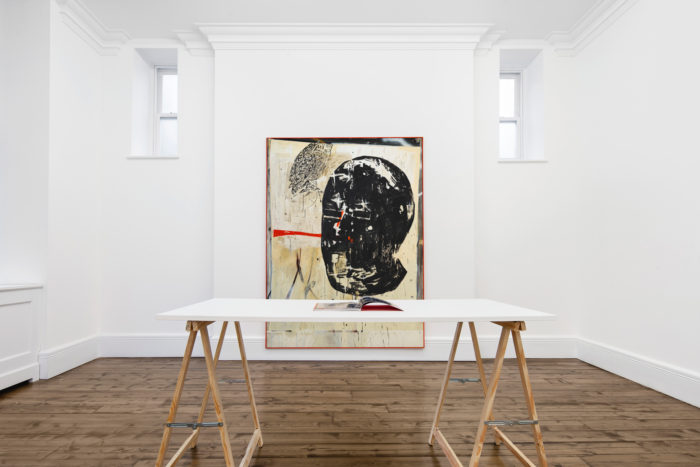
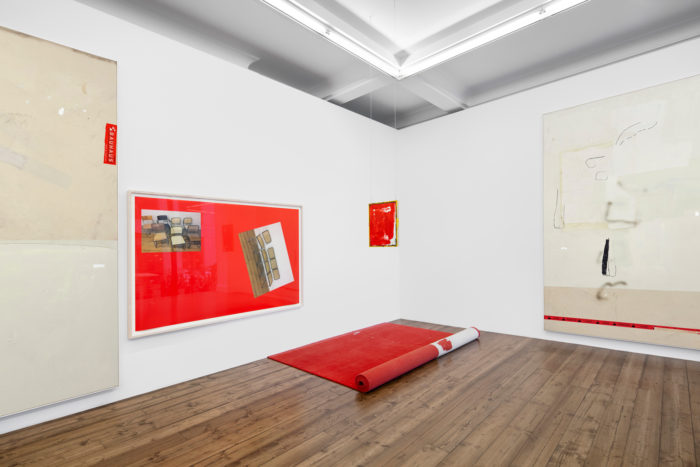
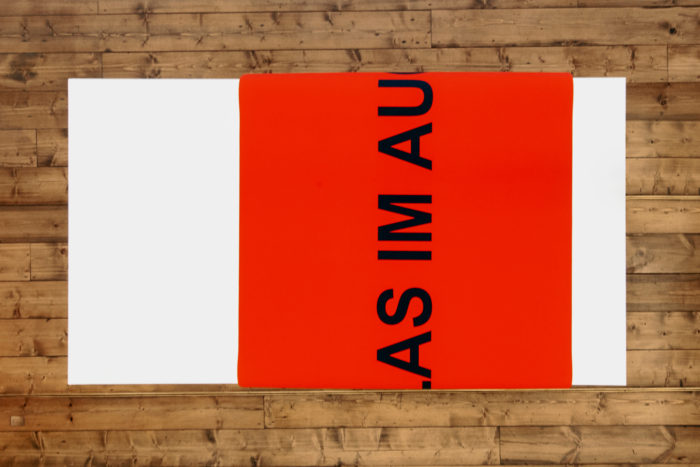
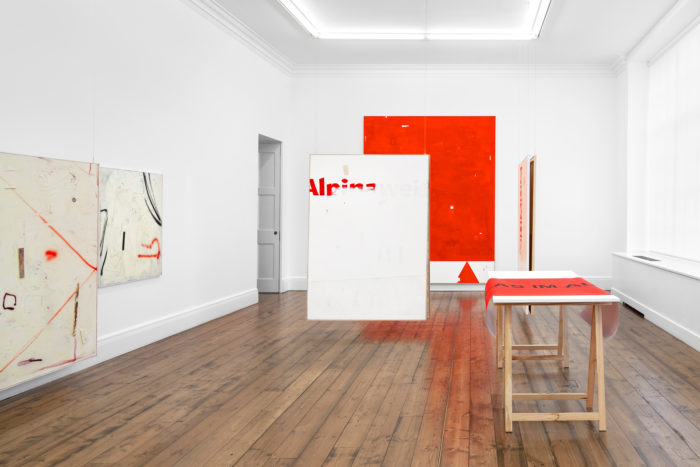
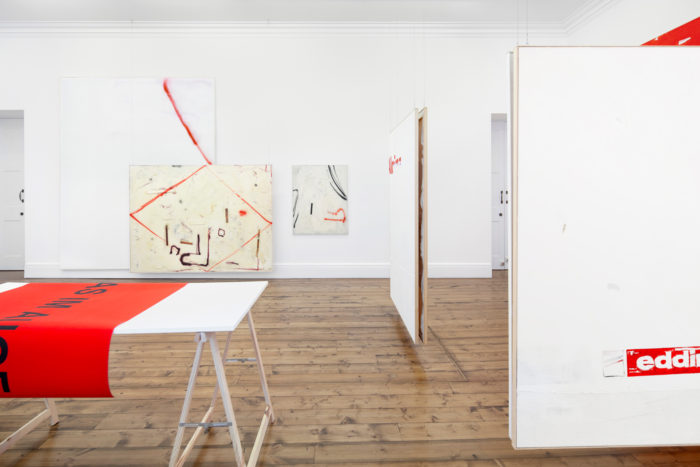
The Thin Red Line is David Ostrowski’s very first solo show with Sprüth Magers in London, for which he has developed a new body of paintings and materials that serve as a meditation on the colour red.
The series was begun earlier this year as part of a new red phase in Ostrowski’s practice, which has focused previously on minimal interventions of blue spray paint and applied elements on largely white or neutral canvases. The colour red had appeared in Ostrowski’s work as early as 2009, but it has taken nearly ten years for him to return to the colour exclusively. The cultural relativity of the colour red was an initial point of interest for the artist; it connotes affairs of the heart for some, has become almost universally synonymous with danger, and represents good luck in other cultures. Grappling with this complex personality and its cultural preconceptions was a central concern for Ostrowski in developing the current works, which have materialized as repositories of the presence and absence of the colour red. The artist applied found materials from his studio, elements such as cotton, wood and paper, to canvases which have been painted in acrylic and lacquer. F (Component), features part of the name of a German paint brand, Alpinaweiß, painted in red acrylic on a pale background, whilst F (Freischwinger) is a digital pigment print of antique chairs superimposed on a red backdrop. Paintings with large areas of paintwork signal Ostrowski’s idiosyncratic painting style – working quickly and spontaneously with fast-drying materials, adding texture and depth through collaged elements.
The accompanying catalogue The Thin Red Line explores further the complexity of the colour red, and should be viewed as part of the exhibition itself. Ostrowski commissioned a series of texts from writers and academics, with ‘red’ as his only specification. In Tenzing Barshee’s fictional text, ‘Very Idea’, the figures A, B and C pontificate on art, and in so doing, characterize red variously as ‘patriarchy’, ‘systemic violence’, ‘the red flag’, ‘lipstick’ and ‘blood vessels’. Meanwhile, Torsten Schmidt takes A Thin Red Line as the title for a fictional narrative about a car crash, which if reflective of the work would mean you would likely endure injury from an accident of a sizable magnitude, whilst other texts explore the sociopolitical, psychological and biological context of the colour red.
The catalogue The Thin Red Line will be published by Mousse Publishing, Milan, in collaboration with Karma Books, New York, with further written contributions from Elisa R. Linn, Gregor Quack and Lennart Wolff.
David Ostrowski (*1981) lives and works in Cologne. Ostrowski studied at the Kunstakademie Düsseldorf with Albert Oehlen from 2004–2009. He was awarded the Atelierstipendium by the Kölnischer Kunstverein and the Imhoff-Stiftung, Cologne, in 2012. Recent solo exhibitions include Bei mir geht es in den Keller hochat Blueproject Foundation, Barcelona (2017), To Lose (a two-man show with Michail Pirgelis) at the Leopold-Hoesch-Museum, Düren (2016), The F Word at the ARKEN Museum, Copenhagen, and I want to die forever at Kunstraum Innsbruck (both 2015), as well as How to do things left at Rubell Family Collection, Miami and Just do it at the Fondazione Sandretto Re Rebaudengo, Turin (both 2014). Ostrowski’s work has also been included in group exhibitions at the M Woods Museum, Beijing (2015), Halle für Kunst & Medien, Graz (2014), and at the ICA, London (2014). Ostrowski’s work also featured in DONT the Music and Art Performance at Halle 9 Kirowwerk, Leipzig (2017).
Installation view, David Ostrowski, ‘The Thin Red Line’, Spru?th Magers, London, November 28, 2018 – January 19, 2019. Photography: Voytek Ketz, London & postproduction by Hans-Georg Gaul, Berlin
